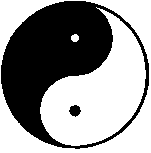
|
|





|







 Taoism refers both to the philosophy outlined in the
Tao Te Ching (identified with
Lao-Tzu) and to China's ancient Taoist
religion. Next to confucianism, it ranks as the second major
belief system in traditional Chinese thought.
Taoism refers both to the philosophy outlined in the
Tao Te Ching (identified with
Lao-Tzu) and to China's ancient Taoist
religion. Next to confucianism, it ranks as the second major
belief system in traditional Chinese thought.The formulation of Taoist philosophy is attributed to Lao-Tzu (fl. 6th or 4th century BC) and Chuang-Tzu (c.369-c.286 BC) as well as the Lieh-tzu (compiled during the Han dynasty, 202 BC-AD 220).
Three doctrines are particularly important: Tao (way) is nonbeing (wu), the creative-destructive force that brings everything into being and dissolves everything into nonbeing; return (fu) is the destiny of everything - that is, everything, after completing its cycle, returns to nonbeing; and nonaction (wu wei), or action in harmony with nature, is the best way of life.
Chuang-tzu taught that, from a purely objective viewpoint, all oppositions are merely the creations of conceptual thought and imply no judgments of intrinsic value (one pole is no more preferable than its opposite). Hence the wise person accepts life's inevitable changes. The Lieh-tzu said that the cultivation of Tao would enable a person to live for several hundred years. Taoism teaches the devotee to lead a long and tranquil life through the elimination of one's desires and aggressive impulses.
| Taoism Religion |
Taoism Tao Te Ching Lao-tzu Chuang-tzu
|
Among the principal Taoist sects to emerge was the Heavenly Master sect, founded in West China in the 2nd century AD. It advocated faith healing through the confession of sin and at one time recruited members as soldiers and engaged in war against the government. The Supreme Peace sect, also founded in the 2nd century, adopted practices much like those of the Heavenly Master sect and launched a great rebellion that went on for several years before ending in AD 205. The Mao-shan (Mount Mao) sect, founded in the 4th century, introduced rituals involving both external and internal alchemies, mediumistic practice, and visionary communication with divinities.
The Ling-pao (Marvelous Treasure) sect, also founded in the 4th century, introduced the worship of divinities called T'ien-tsun (Heavenly Lords). The Ch'uan-chen (Completely Real) sect was founded in the 12th century as a Taoist monastic movement. Eventually the Heavenly Master sect absorbed most of the beliefs and practices of the other sects and, in the 20th century, became the most popular Taoist group.
| Tao Te Ching |
Taoism Religion Lao-tzu Chuang-tzu
|
| Lao-tzu (Laozi) |
Taoism Religion Tao Te Ching Chuang-tzu
|
| Chuang-tzu (Zhuangzi) |
Taoism Religion Tao Te Ching Lao-tzu
|
Among the Taoist canons, the Chuang-tzu, a collection of Chuang-tzu's essays, is perhaps the most influential. Its impact is felt by rival schools of philosophy, as shown in the development of confucianism and zen buddhism. It has especially inspired Chinese art and poetry. The extant version of the Chuang-tzu, compiled by the commentator Kuo Hsiang in the 3rd century BC, consists of 33 chapters. The uneven style suggests spurious additions by later hands; but the first seven "Inner Chapters" and a few others that are thought to be genuine demonstrate the author's great imagination and originality as a writer as well as a philosopher. His prose is rich in poetic imagery; his arguments are driven home with fantastic allegory and the humorous dialogue of imaginary persons.
Go to the top of the page